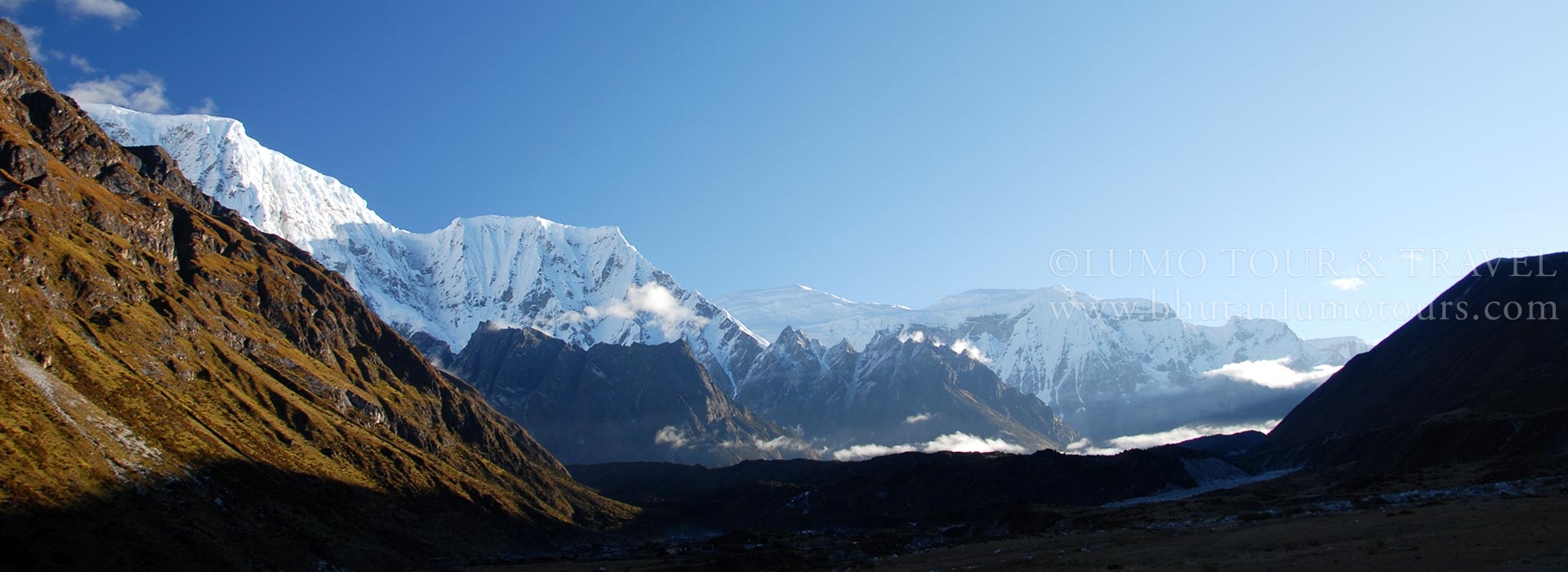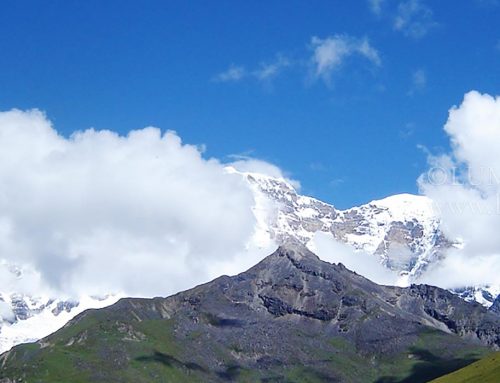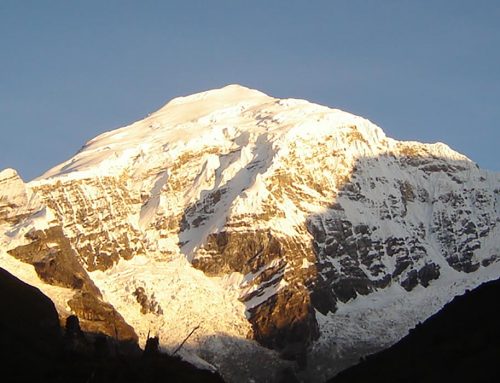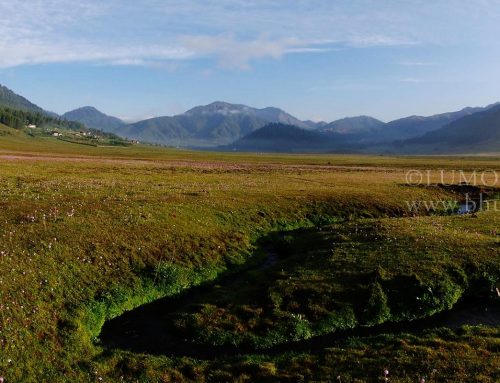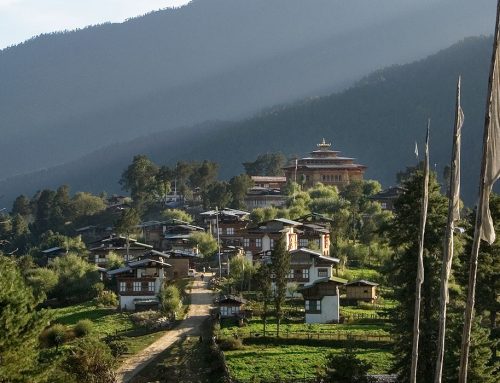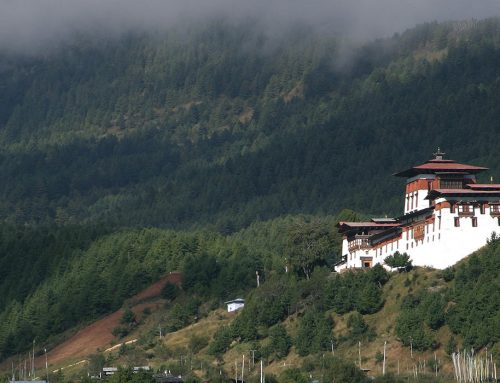- Duration: 29 nights / 30 days.
- Accommodation: Hotels, Resorts and Tents.
- Activity Type: Trekking & Tour.
- Difficulty Level: Extremely Strenuous.
- Highest Point: 5290 meters.
- Group size: Minimum 2 pax.
- Best Months for the Trek: March – May, September – 2nd week of November.
- Spectacular view of Mount Jhomolhari (7314m).
- Opportunity to witness diverse flora and fauna.
- Opportunity to spot the blue sheep.
- Experience the unique culture of Laya people.
- Excursion to the famous Taktsang – “The Tiger’s Nest”.
- Visit Drugyal Dzong (The ruined Victory Fortress, built in1644), Kichu Monastery, Trongsa Dzong, Chendebji Chorten, Chimi Lhakhang – “The Temple of Fertility”, Paro Dzong, National Museum.
- Opportunity to see Bhutanese farmhouses, glacial lakes, and majestic mountains like Mt. Jhumolhari, Mt. Masangang, Mt. Jichu Drake, Table Mountain, and others.
- Opportunity to meet the Layaps (highlanders) and experience their lifestyle.
Day 1: Arrive at Paro Bhutan by Druk Air
Arrive Paro by Druk Air, the national carrier. The flight offers you beautiful views of mountains on your approach. On arrival and after visa formalities you will be received by our representatives and transferred to your very comfortable hotel.
In the afternoon you will have the opportunity to explore Paro town a little and visit Paro Dzong. A Dzong is part fortress, part castle, part monastery and part administration building. Paro Dzong is one of Bhutan’s most impressive and well-known Dzongs, and the finest example of Bhutanese architecture. The tapering walls form a massive structure that towers over the town and is visible as a great white monolith from vantage points throughout the valley. Paro is at 2280 metres (7500 ft).
Day 2: Day Hike to Taktsang Monastery
Day hike to Taktsang Monastery, the famous “Tiger’s Nest”. Horses can be arranged for an extra US$ 5. The hike which is all uphill takes about 2 to 3 hours through villages and pine forests. The monastery which clings to a huge granite cliff 800 meters above the Paro valley was devastated by fire in 1998 but the Royal Government has taken immediate steps to restore the monastery to its original structure. It is believed that the Buddhist saint Padmasambhava came in the 7th century on a flying tigress and meditated in a cave for 3 months. During the end of the 17th century, a monastery was built on the spot where the saint meditated and it is a pilgrimage site for every Bhutanese to visit once in their lifetime. Walk back to hotel.
DAY 3: Drukgyel Dzong to Sharna
Distance: 17km – 5 to 6 hours
A short drive from Paro takes us to Drukgyel Dzong, and the start of our trekking route. Heading up the Pachhu River valley, the trail passes the small settlements of Chang Zampa and Mitshi Zampa where we will see excellent examples of Bhutanese farmhouses. We camp at Sharna (2800m / 9200 feet).
DAY 4: Sharna to Thangkthanka
Distance: 22km – 7 to 8 hours
Leaving Sharna, the trail continues upriver and the route winds in and out of rhododendron and blue pine forests. When we enter Jigme Dorji National Park keep your eyes open for wildlife and changes in vegetation as we continue to climb in elevation. Tonight we camp in Thangthangka (3520m / 11545 feet).
DAY 5: Thangthanka to Jangothang
Distance: 19km – 5 to 6 hours
An hour out of camp this morning we leave the tree line and head into the high mountains. At the halfway point of our hike, we cross Tengethang, a winter home of the migratory yak herders. Arriving at Jangothang (4040m / 13,250 ft), we can watch the sun set on Mt. Jhomolhari (7314m) and Mt. Jichu Drake (6989m).
DAY 6: Rest day in Jangothang
The first of our acclimatization days, we have many day-hiking options. The first is a three to four hour excursion up the ridge to the north for great views of Mt. Jichu Drake. The second is to hike up towards the head of the valley in the direction of Mt. Jhomolhari. The third is a trek up the main valley towards the last house and onward toward Mt. Jichu Drake, this gives a great view of where we will be going in the next few days. The final alternative is a fishing expedition to Tshophu, a high-altitude lake about a two hour hike away.
DAY 7: Jangothang to Lingshi
Distance: 20km – 6 to 7 hours
Heading uphill from Jangothang we cross the first of many major passes. The Nyilela Pass at 4890m (16,135 ft) is about four hours ascent. Descending the other side we will encounter spruce juniper and rhododendron and pass many yak herders’ camps. From this area on we start to see herds of blue sheep. Arriving in Lingshi we set up camp at 4150m (13,700 ft).
DAY 8: Lingshi to Chebisa
Distance: 14km – 4 to 5 hours
This morning we will visit Lingshi Dzong, also known as Yugyel Dzong in the 17th century, it was used in the past to control travel between Tibet and Bhutan. Since today’s hike will not be as long, the pace will be more relaxed. Upon reaching the camp at Chebisa (3850m / 12,600 ft), we will have time to visit Chebisa village and see a bit of Bhutanese village life.
DAY 9: Chebisa to Shakshepasa
Distance: 13km – 4 hours
Crossing the Gombula Pass at 4350m (14,300 ft), we descend into a rhododendron filled valley, and continue past some yak herders’ camps to Shakshepasa where we camp at 3980m (13,100 ft).
DAY 10: Shakshepasa to Robluthang
Distance: 18km – 7 to 8 hours
An early morning start will get us on the way to Jharila Pass at 4747m (15,600 ft). Descending to Tsharijathang, the valley where herds of Takin (the national animal of Bhutan) are normally seen. From here we climb to our camp at Robluthang at 4160m (13,700 ft).
DAY 11: Robluthang to Limithang
Distance: 19km – 7 to 8 hours
Starting early a strenuous hike leads to the Shingela Pass at 5005m (16,650 ft). Descending to Lemithang we’ll see Mt. Gangchenta (6840m) and the glacially carved Gangchhenta valley. Gangchhenta means Great Tiger Mountain. We camp at 4140m (13,650 ft).
DAY 12: Limithang to Laya.
Distance: 10km – 4 to 5 hours
A shorter hike follows a trail in and out of a heavily wooded, uninhabited valley. Climbing up out of the forests we will be rewarded with some great views of Gangchhenta and Masangang (7165m) mountains. We camp at Laya at 3840m (12,650 ft).
DAY 13: Rest day in Laya
Resting in Laya for the day we will get a chance to see the village with its community school, hospital, archery field and the first shop since the Paro Valley. Laya is a unique village of about 800 people with their own language, customs and distinct dress. The women keep their hair long and wear peculiar conical bamboo hats with a bamboo spike at the top. They wear a lot of silver jewellery.
DAY 14: Laya to Rodufu
Distance: 19km – 6 to 7 hours
The trek leads gradually downhill to the Lunana trail junction, then makes a gradual climb to the camp through a forest of conifers, maple and rhododendron. The trail improves and becomes wider as we climb out of the river valley. We camp at Rodufu near a small stream at 4160m (13,645 ft).
DAY 15: Rodufu to Narethang
Distance: 16km – 8 to 9 hours
It is a long hike, first crossing the Tsimola Pass at 4950m (16,200 ft). Descending to Narethang we pass some dwarf rhododendron and hike in the shadow of Gangla Karchung peak (6395m). We camp at 4900m (16,000 ft).
DAY 16: Narethang to Tarina
Distance 18km – 5 to 6 hours
Climb to Karchungla Pass at 5240m (17,187 ft) and down to the glacial lakes that are the source of the Tangchu River. Above the lakes are the mighty peaks of Jejekangphu Gang (7300m) and Tsenda Kang (7100m). We camp at Tarina, 4020m (13,250 ft).
DAY 17: Tarina to Woche
Distance: 15km – 5 to 6 hours
The walk leads down through conifer forests, following the upper reaches of the Phochhu River. The trail then climbs over a ridge and drops to the village of Woche at 3940m (13,000 ft). The trek has now entered the Lunana region.
DAY 18: Woche to Lhedi
Distance: 19km – 7 to 8 hours
It’s a gradual climb from Woche to the Kechela Pass at 4580m (15,100 ft), then downhill to Thega village. The hike continues to Lhedi village where we camp at 3600m (11,800 ft).
DAY 19: Lhedi to Thanza
Distance: 19km – 6 to 7 hours
The trail climbs gradually following the main source of the Phochhu to Chozo village. At the small Chozo Dzong there are some lay monks. Above Chozo the valley opens as we approach Thanza village near the foot of 7100m Zogophu Gamp, which is also known as Table Mountain. We camp at Thanza, 4080m (13,300 ft).
DAY 20: REST DAY IN THANZA, 4080m (13,300 ft).
This day is a fantastic opportunity to interact with the hospitable local villagers, and explore the beautiful surrounding area, our farthest point in the Lunana valley. Alternatively you can relax around camp and rest up for some of the tough days ahead. As Thanza is a transfer point for horses and yaks, it is important to have a day here for our staff to ensure all the necessary yaks are rounded up by the local herders who do not operate on western time.
DAY 21: Thanza to Danji
Distance: 8km – 4 hours
Today is a relatively short, although somewhat steep, climb to a campsite called Danji, part way up to the Jazela Pass. It will allow us to have some extra time in the morning and make a later start. The camp is around 4600m/15,000ft, with spectacular views of snow-capped peaks! It is an important acclimatization spot.
DAY 22: Danji to Tso Chena
Distance: 12km – 5 hours
The first part of the day involves a climb up over three false summits to Jazela Pass at 5050m (16,570ft). From the pass it is a short downhill trek to the campsite at the lake of Tso Chena at 4800m (15,740 ft). Keep your eyes open for blue sheep during the hike.
DAY 23: Tso Chena to Jichu Dramo
Distance: 14km – 4 to 5 hours
The trail has a series of gradual ups and downs between the snow-capped peaks and across the Lojula Pass at 4940m (16,300 ft) before descending to camp at Jichu Dramo at 4880m (16,000 ft).
DAY 24: Jichu Dramo to Chukarpo
Distance: 18km – 5 to 6 hours
We start with a hard climb to Rinchen Zoela Pass at 5290m (17,350 ft), the highest on the trek. It is then all downhill to Chukarpo, which is just above the tree line at 4950m (16335 ft).
DAY 25: Chukarpo to Thampe Tso
Distance: 18km – 5 to 6 hours
It is a long mostly downhill walk along the river, followed by a climb up to the Um So Lake at 4230m (13,950 ft). In this lake Pema Lingpa revealed a number of religious treasures. Continuing downhill we camp by the lake of Thampe Tso at 4200m (13,860 ft).
DAY 26: Thampe Tso to Maurothang
Distance: 14km – 5 hours
It is a short walk to the base of Thampe La and a steep climb to the pass at 4580m (15,100 ft). The trek is then all downhill through rhododendron bushes to the yak pasture of Maurothang where we camp at 3550m (11,640 ft).
DAY 27: Maurothang to Nikachu Chazam / Drive to Punakha
Distance: 23km – 7 to 8 hours
A long final day of trekking will descend through the lovely village of Sephu to finish at Nikachu Chazam, the road head. From there we will drive to a comfortable guest house near Trongsa. This beautiful Dzong is the centre of the region of Bhutan called “Bumthang” (central region). The Trongsa Dzong is the most impressive in the kingdom and can be seen from a great distance in its strategic position high above the Mangdechhu River.
Drive from Trongsa to Punakha. (Approximately 3 hours). In the mid-afternoon, there is a spectacular drive back west across the mountains to Punakha. We will probably stop along the way at Chendebji to visit the Chendebji Chorten, patterned after Swayambhunath in Kathmandu and built in the 19th century by Lama Shida from Tibet. We may also stop at the top of the Pelela Pass (3400m). Overnight in Punakha in a very comfortable hotel.
DAY 28: Drive Punakha to Thimphu
We will have time in the morning to see Punakha Dzong (the second of Bhutan’s dzongs to be built) which for many years served as the seat of government. The Dzong was first built in 1637 and is still one of the largest in Bhutan. We will drive to Thimphu in the morning (about 2 hours) and have the afternoon to visit Thimphu, the capital of Bhutan. We will visit the Tashichhodzong, built as the symbol of the capital and then explore the shops along Norzin Lam, Thimphu’s main street.
DAY 29: Drive Thimphu to Paro
The morning is free to do some more sightseeing or shopping around Thimphu. In the afternoon we take a 2 hour drive through the lovely central foothills to Paro where we will halt overnight in a comfortable hotel.
DAY 30: Paro to Kathmandu
Waking up in Paro, we’ll have time for one last walk through town before saying our goodbyes and heading to the airport for the Druk Air flight to Bangkok.
- Hike to Jumolhari Glacier, around 4 ½ hours (back and forth)
- Hike to Jichu Drake Glacier, around 3 hours (back and forth)
- Walk up the mountain between Jumolhari and Jichu Drake, the summit is at 5200 meters with a great view of both the mountains. This is 8 hours (back and forth)
- Excursion to Chelela Pass
- Rafting in Pho Chu (Punakha)
Cost inclusive of:
- All Meals [Breakfast /Lunch/Dinner]
- Accommodation [Twin Sharing] Single Room Supplement Extra US $: 40 per room per night.
- All transportation within the country including airport transfers.
- Royalty & Govt. Taxes
- Entrance fees for Museums and Monuments only
- Visa Fee
- Airport tax
- Contribution to Tourism Development Fund
- Guide
- Sightseeing
While on trek, cost covers:
- Nature Recreation and Ecotourism Division (NRED) Nu.1000
- 3 meals a day
- Service of cook & helper
- Guide, sleeping tent
- Mess Tent, Kitchen Tent & Toilet Tent
- Ponies to carry supplies
- Royalty
- We will provide you with sleeping mats but you have to bring your own sleeping bags.
Cost exclusive of:
- Druk Air fare
- Insurance Premiums
- Payments for service provided on a personal basis
- Cost for any services not mentioned in the “Cost Include Head”
- Cost incurred due to mishaps, strikes, political unrest, etc.
- Personal expense in items such as laundry, soft drinks, camera charges, bottled water, incidentals, portage, bellboy charges, tips or any other services
Personal clothing: strong normal clothing (according to season). Preferably cotton, even for summer, woolen clothing for the evening and winter.
For Trekking, one must bring:
- Strong comfortable trekking boots – water-resistant for the rainy period of June-August
- Sunscreen
- Flash light
- Rain coat (especially for rainy period – June-August)
- Head gear/hat/cap for sun and rain protection
- Water pills – for extra caution in purifying stream; (boiled water is provided at all times during the trek)
- Aspirin – incase of altitude sickness
- Lots of socks
- Warm clothes
OPTIONAL ITEMS
- Sunglasses
- Headgear
- Folding umbrella (only for wet months — July and August)
- One towel
- Pillow case
- Wet-packed tissue paper
- Pillow


